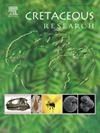加拿大不列颠哥伦比亚省温哥华岛岩石海岸线演替中的不寻常生物面貌:东北太平洋地区晚白垩世珊瑚藻类的首次记录
IF 1.9
3区 地球科学
Q1 GEOLOGY
引用次数: 0
摘要
在不列颠哥伦比亚省温哥华岛出发湾的白垩纪碎屑岩地层中,发现了三种常见形态的Sporolithon sp.以及peyssonneliacean红藻Polystrata。虽然已知日本白垩纪有珊瑚藻,但北美太平洋沿岸的白垩纪还没有发现过这种藻类。与珊瑚藻类相关的软体动物表明其年龄为坎帕尼亚晚期早期至中期早期,与纳奈莫组地层所代表的最高古温度时间一致。珊瑚藻发现于砾岩和砂岩中,代表了上白垩世纳奈莫组演替的基底横切面,与上三叠世卡穆森地层的枕状玄武岩不整合。这种岩石海岸线面貌与众不同,呈现出大面积的珊瑚藻类包岩沉积。在珊瑚藻中还发现了古蝶形虫,这是东北太平洋地区白垩纪中第一例浅海痕量化石。本文章由计算机程序翻译,如有差异,请以英文原文为准。
An unusual biofacies in a rocky shoreline succession of Vancouver Island, British Columbia, Canada: First record of Late Cretaceous coralline algae from the northeast Pacific region
Three common morphotypes of Sporolithon sp., as well as the peyssonneliacean red algae Polystrata, have been identified from Cretaceous clastic strata of Departure Bay, Vancouver Island, British Columbia. While coralline algae are known from the Cretaceous of Japan, they have not been recognized previously from the Cretaceous of the Pacific coast of North America. Mollusks associated with the coralline algae indicate an age of late early to early middle Campanian, corresponding to the time of maximum paleotemperature as represented in strata of the Nanaimo Group. The coralline algae are found in conglomerate and sandstone representing a basal transgressive facies of the Upper Cretaceous Nanaimo Group succession, resting unconformably on pillow basalts of the Upper Triassic Karmutsen Formation. This rocky shoreline facies is unusual in exhibiting extensive coralline algae packstone deposits. Paleodictyon is also found with the coralline algae, the first shallow-marine example of this trace fossil from the Cretaceous of the northeast Pacific region.
求助全文
通过发布文献求助,成功后即可免费获取论文全文。
去求助
来源期刊

Cretaceous Research
地学-地质学
CiteScore
4.10
自引率
19.00%
发文量
235
审稿时长
12 weeks
期刊介绍:
Cretaceous Research provides a forum for the rapid publication of research on all aspects of the Cretaceous Period, including its boundaries with the Jurassic and Palaeogene. Authoritative papers reporting detailed investigations of Cretaceous stratigraphy and palaeontology, studies of regional geology, and reviews of recently published books are complemented by short communications of significant new findings.
Papers submitted to Cretaceous Research should place the research in a broad context, with emphasis placed towards our better understanding of the Cretaceous, that are therefore of interest to the diverse, international readership of the journal. Full length papers that focus solely on a local theme or area will not be accepted for publication; authors of short communications are encouraged to discuss how their findings are of relevance to the Cretaceous on a broad scale.
Research Areas include:
• Regional geology
• Stratigraphy and palaeontology
• Palaeobiology
• Palaeobiogeography
• Palaeoceanography
• Palaeoclimatology
• Evolutionary Palaeoecology
• Geochronology
• Global events.
 求助内容:
求助内容: 应助结果提醒方式:
应助结果提醒方式:


